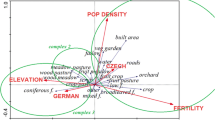Abstract
In China both agriculture and agroforestry originated in forests and developed side by side from their very beginnings. As revealed by archaeological evidence from ancient times, ancestral Chinese inhabited forests where they sheltered themselves from external hazards and lived on the edible parts of plants and animals through hunting and gathering activities.
As early as the New Stone Age (7000–8000 years B.C.), fire was commonly used to burn the forests for slash-and-burn cultivation, which is a primitive form of agroforestry. Along with the rapid growth of population, the annexing of tribes, the collapse of clan society and the development of the slavery system, the nomadic mode of slash-and-burn farming evolved into settlement farming in the Xia Dynasty (2000-1600 B.C.). Peasants then engaged in settled cultivation.
During the Shang and West Zhou Dynasty (1600-800 B.C.), perpetual settlement farming encouraged the development of private land-ownership. Peasants planted trees in or around the crop fields and grew fruit plants, vegetables and farmed domestic animals in their home yards for self-sufficiency. Since then, various forms of agroforestry have gradually developed and laid the fundamental framework of the Chinese small-farming economy for more than 3000 years.
There has been a rapid growth of population in China over since the 1950s. At the same time, the area of arable land has decreased drastically and the environment has degraded rapidly as industrial development has taken place. The traditional labour-consuming and ineffective agroforestry management practices have not adapted to the current situation. In view of economic, ecological and social benefits, conversion of mono-biological production into a trinity system of agriculture, processing and marketing is suggested and planned experimentally. Such a management system, known as modern agroforestry, could be very beneficial to the development of modern China's rural economy and environmental conservation.
Similar content being viewed by others
References
Agricultural Heritage Institute of China (ed) (1984) Agricultural History of China. Science Press, Beijing, China [in Chinese]
Archaeological Institute, Chinese Academy of Social Sciences (ed) (1984) Archaeological Discoveries and Studies in New China. Cultural Relics Press, Beijing, China [in Chinese]
Deng HH (1986) Neo-Agricultural Resolution. Guangxi People's Press, Nanjing, China [in Chinese]
Du SR (1982) History of China's Sciences and Technology. Science Press, Beijing, China [in Chinese]
Hsiung WY (1991) Ecosystem engineering and modern agroforestry. Journal of Ecology 10(1): 21–26 [in Chinese]
Hsiung WY and Zou JW (1985) On ecosystem engineering. Journal of Nanjing For Univ 1: 1–11 [in Chinese]
Hu ST (1988) Ecological Agriculture. Hubei Science and Technology Press, Wuhan, China [in Chinese]
King KFS (1987) The history of agroforestry. In: Steppler HA and Nair PKR (eds) Agroforestry: A Decade of Development, pp 3–11. International Centre for Research in Agroforestry (ICRAF), Nairobi, Kenya
Mei XH (1983) Approaches to ecosystems of mulberry plantations with crops, vegetables and animal husbandry. Journal of Ecology 2(4): 46–49
Qian XS (1988) System Engineering. Hunan Science and Technology Press, Chang Sha, China [in Chinese]
Sharma TC (1976) The Prehistoric Background of Shifting Cultivation. Proceedings of a Seminar on Shifting Cultivation in North-East India. India Council for Social Sicnece Research, New Delhi, India
Sheng WT (1983) Site preparation for Chinese fir planting. In: Wu ZH (ed) Chinese Fir, pp 387–402. Chinese Forestry Press, Beijing, China [in Chinese]
Tang QG (1985) History of China's Agriculture. Agric Press, Beijing, China [in Chinese]
Yan WI and Yi YH (1991) History of China's Agricultural Development. Tianjin Science and Technology Press, Tianjin, China
Yang TX (1987) Consideration of China's Agriculture. Office of Agricultural Modernization, Chinese Academy of Sciences, Shijiazhuang, China
Yu XT and Shen PQ (1983) Tree-crop interplanting. In: Wu ZH (ed) Chinese Fir, pp 431–441. Chinese Forestry Press, Beijing, China, [in Chinese]
Zhang JC (1992) Introduction to China's Traditional Forestry. Chinese Forestry Press, Beijing, China [in Chinese]
Zhu D (1988) Studies on Primitive Culture. Unite Book Store of Life, Study and Knowledge, Hongkong, China [in Chinese]
Zhu ZN (1988) On systematic optimal structure of agriculture. In: Xu GZ (ed) Application Examples of System Engineering, pp 49–55. Science Press, Beijing, China [in Chinese]
Author information
Authors and Affiliations
Rights and permissions
About this article
Cite this article
Hsiung (Xiong), W., Yang, S. & Tao, Q. Historical development of agroforestry in China. Agroforest Syst 30, 277–287 (1995). https://doi.org/10.1007/BF00708926
Issue Date:
DOI: https://doi.org/10.1007/BF00708926




